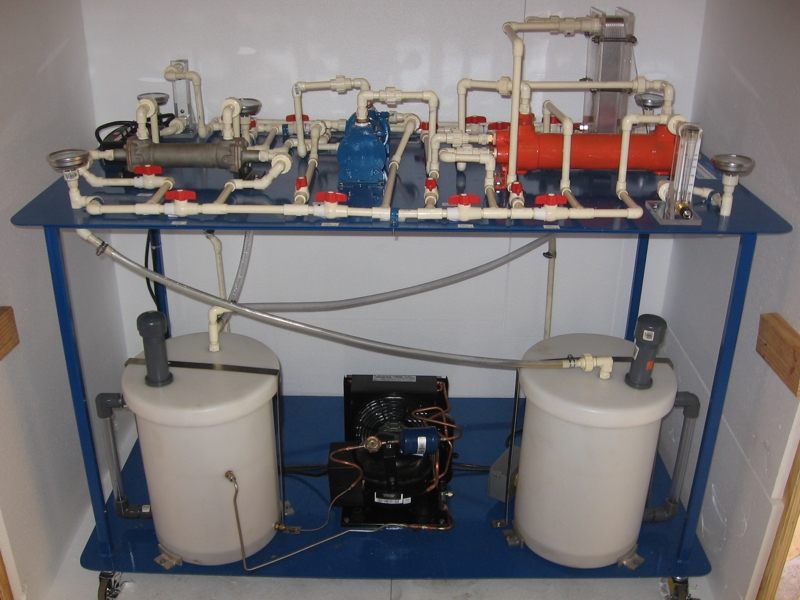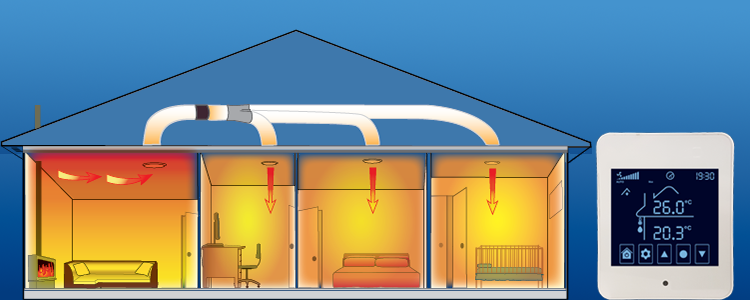A Practical Installation Guide for DVS Heat Transfer Systems in Smart Manufacturing
The Duty of Heat Transfer Systems in Sustainable Energy Solutions for the Future
Heat transfer systems are crucial in the pursuit for lasting power solutions. They optimize thermal energy monitoring, boosting the effectiveness of sustainable technologies. By using devices like transmission, convection, and radiation, these systems minimize power losses. Their role in solar thermal and geothermal applications is specifically substantial. As advancements emerge, the possibility for further innovations increases crucial questions regarding future power approaches. What growths will shape the landscape of lasting energy?
Comprehending Heat Transfer Solutions

The Significance of Thermal Power Management
Reliable thermal energy administration is vital for taking full advantage of power performance and minimizing waste in various systems. By controling temperature and enhancing Heat transfer processes, companies can significantly minimize power usage and functional prices. Effective administration entails the implementation of advanced technologies and methods that keep track of and control thermal conditions within systems, making certain that power resources are utilized efficiently. On top of that, correct thermal power management adds to minimizing greenhouse gas discharges, lining up with global sustainability goals. It additionally boosts system reliability and efficiency, causing improved product quality and longer equipment lifespan. Inevitably, focusing on thermal power administration is a crucial action in the direction of creating extra lasting energy solutions and fostering a liable method to power usage in domestic and industrial contexts.
Applications of Heat Transfer in Renewable Resource
While different renewable resource sources assure sustainability, the effective application of Heat transfer plays an important duty in their effectiveness. In wind energy systems, Heat transfer is used for turbine element cooling, boosting efficiency and long life. Geothermal power counts on efficient Heat exchange between the earth's subsurface and the fluid flowing in the system, taking full advantage of energy extraction. Biomass energy processes likewise take advantage of Heat transfer, as it assists in converting natural products into functional fuel with pyrolysis and gasification. In addition, in hydropower, preserving perfect temperatures in tanks can enhance power outcome. Each of these applications shows the critical importance of Heat transfer systems in enhancing renewable energy modern technologies, eventually adding to a much more lasting power future.
Enhancing Solar Thermal Power Efficiency
As solar thermal power systems remain to advance, improving their performance has actually become vital for taking full advantage of power result. Advancements in Heat transfer modern technologies, such as improved thermal storage space products and innovative Heat exchangers, play a considerable duty in improving performance. By utilizing advanced materials that have exceptional thermal conductivity, systems can capture and transfer Heat better. Additionally, integrating radar that comply with the sun's course assurances that collection agencies receive excellent solar direct exposure throughout the day. Making use of nanotechnology in solar absorbers can further boost power absorption prices. Moreover, incorporating automated control systems helps manage and regulate temperature levels power circulation efficiently, bring about minimized losses and enhanced total system performance. These enhancements pave the method for more lasting solar thermal energy remedies in the future.
Geothermal Heating: A Sustainable Solution
Geothermal heating provides a sensible option for lasting power, supplying considerable environmental benefits through lowered greenhouse gas emissions. Its effectiveness and cost-effectiveness make it an eye-catching choice to standard furnace. Obstacles connected to implementation needs to be resolved to optimize its prospective influence.
Ecological Benefits of Geothermal
Standard heating approaches add considerably to greenhouse gas exhausts, geothermal heating offers a compelling choice that reduces environmental influence. By using the Earth's internal Heat, geothermal systems use a renewable resource source, substantially lowering dependence on fossil gas. This method creates minimal carbon exhausts, making it a cleaner choice for household and commercial heating. Furthermore, geothermal systems advertise energy performance, as they call for much less energy compared to standard heater. DVS Heat Transfer Systems. The usage of geothermal power also helps in minimizing air contamination, improving local air top quality and public health. As a lasting remedy, geothermal heating supports environment modification mitigation efforts, positioning itself as a vital element in the shift in the direction of a greener future
Efficiency and Cost-Effectiveness
Exactly how does geothermal heating gauge up in terms of effectiveness and cost-effectiveness compared to typical furnace? Geothermal home heating shows premium performance, usually attaining a coefficient of efficiency (POLICE) of 3 to 5, implying it creates 3 to 5 devices of Heat for every device of electricity consumed. This effectiveness translates right into lower operating expense, particularly in regions with steady geothermal resources. Preliminary installation prices can be greater than conventional systems; however, long-lasting cost savings on power bills and decreased upkeep expenses can counter these upfront investments. In addition, several federal governments incentivize geothermal systems through refunds and tax credit histories, enhancing their cost-effectiveness. Overall, go to website geothermal heating arises as a lasting and financially sensible choice to more conventional heating options.
Execution Obstacles and Solutions
Countless difficulties can hinder the extensive implementation of geothermal heater, in spite of their clear benefits as a sustainable power remedy. High preliminary installment prices frequently discourage property owners and investors, making funding a considerable obstacle. Additionally, the geographical constraints of suitable geothermal websites limit availability in certain regions. Local policies and permitting procedures can likewise make complex job growth, leading to delays. Public awareness and understanding of geothermal systems continue to be low, impeding approval. To address these challenges, targeted education campaigns can enhance open secret, while government incentives could relieve economic worries. Collaborating with local authorities to enhance guidelines might help with smoother job approvals, eventually advertising the adoption of geothermal home heating as a feasible, lasting energy alternative.
Technologies in Heat Transfer Technologies
Technologies in Heat transfer modern technologies play a vital role in boosting energy effectiveness and sustainability. Advanced Heat exchangers and phase adjustment materials go to the forefront of these advancements, using significant renovations in thermal management. These modern technologies not only optimize energy usage yet also add to minimizing ecological impact in numerous applications.
Advanced Heat Exchangers
Advanced Heat exchangers play an important this role in boosting power effectiveness throughout various applications in sustainable energy solutions. These tools promote the transfer of Heat in between two or more fluids, substantially minimizing power usage in processes such as industrial heating, air conditioning, and power generation. Developments in materials and layout, such as making use of nanofluids and compact configurations, have actually led to boosted thermal efficiency and minimized dimension requirements. Furthermore, innovations in electronic surveillance and control systems enable enhanced operation, additional enhancing effectiveness. By decreasing waste Heat and maximizing power healing, advanced Heat exchangers add to decrease carbon footprints and support the shift towards ecologically pleasant innovations. Their continued development is important for attaining international energy sustainability objectives.
Stage Modification Products
The combination of stage change products (PCMs) into Heat transfer innovations represents a significant improvement in power administration and performance. PCMs absorb and launch thermal energy throughout their phase modifications, allowing reliable temperature policy in structure products and power systems. By storing excess Heat during peak durations and launching it when demand rises, PCMs add to fill changing and power preservation - DVS Heat Transfer Systems. This capacity go now enhances the efficiency of renewable resource systems, especially in solar thermal applications. Furthermore, PCMs can enhance the thermal comfort of indoor atmospheres, minimizing dependence on standard home heating and cooling down methods. As technologies in PCM formulas remain to emerge, their role in sustainable power options is poised to grow, offering promising opportunities for future research study and application

Future Potential Customers for Heat Transfer in Lasting Power
As the demand for sustainable power services remains to rise, the duty of Heat transfer systems is ending up being increasingly critical in forming future modern technologies. Innovations in products and styles are expected to boost efficiency in Heat transfer, decreasing energy losses in different applications. The combination of sophisticated thermal storage systems, such as phase adjustment materials and thermochemical storage, will make it possible for far better administration of power sources. Research study right into nanofluids and biomimetic Heat exchangers might even more enhance thermal efficiency. Moreover, the fostering of smart technologies will certainly enable real-time tracking and adaptive control of Heat transfer procedures. These developments are poised to greatly contribute to the total efficiency and sustainability of power systems, paving the method for an extra energy-efficient future.
Often Asked Concerns
How Can People Apply Heat Transfer Solution in your home?

Individuals can execute Heat transfer systems in the house by installing energy-efficient devices, utilizing glowing heating, and optimizing insulation. These steps improve energy effectiveness, reduce costs, and advertise lasting methods in property atmospheres.

What Are the Expenses Related To Mounting Heat Transfer Solutions?
The costs connected with installing Heat transfer systems vary commonly, normally encompassing tools, setup labor, and maintenance. Aspects such as system type, home dimension, and neighborhood regulations significantly influence the overall expenditure involved.
Exist Government Rewards for Heat Transfer System Installations?
Government incentives for Heat transfer system installments differ by area and can include tax rebates, gives, and credit reports. These monetary benefits intend to motivate fostering, inevitably advertising power efficiency and decreasing environmental influence within neighborhoods.
How Do Heat Transfer Solutions Influence Energy Costs?
Heat transfer systems significantly affect power bills by enhancing power performance. By boosting the transfer of Heat, these systems decrease energy usage, leading to lower energy prices and producing a more sustainable technique to power management.
What Upkeep Is Required for Heat Transfer Systems?
Maintenance for Heat transfer systems consists of normal assessments, cleansing of components, inspecting fluid levels, making certain appropriate insulation, and changing worn components. These jobs aid preserve effectiveness, stop break downs, and prolong the system's operational life expectancy.
These systems promote the activity of thermal energy from one tool to an additional, allowing the transfer of Heat for home heating, power, or cooling generation functions. Geothermal energy counts on effective Heat exchange between the earth's subsurface and the liquid distributing in the system, making best use of energy removal. Furthermore, geothermal systems promote energy efficiency, as they need less power compared to traditional heating systems. Advanced Heat exchangers play a necessary role in boosting energy effectiveness throughout various applications in lasting energy options. Heat transfer systems significantly affect energy costs by maximizing energy efficiency.